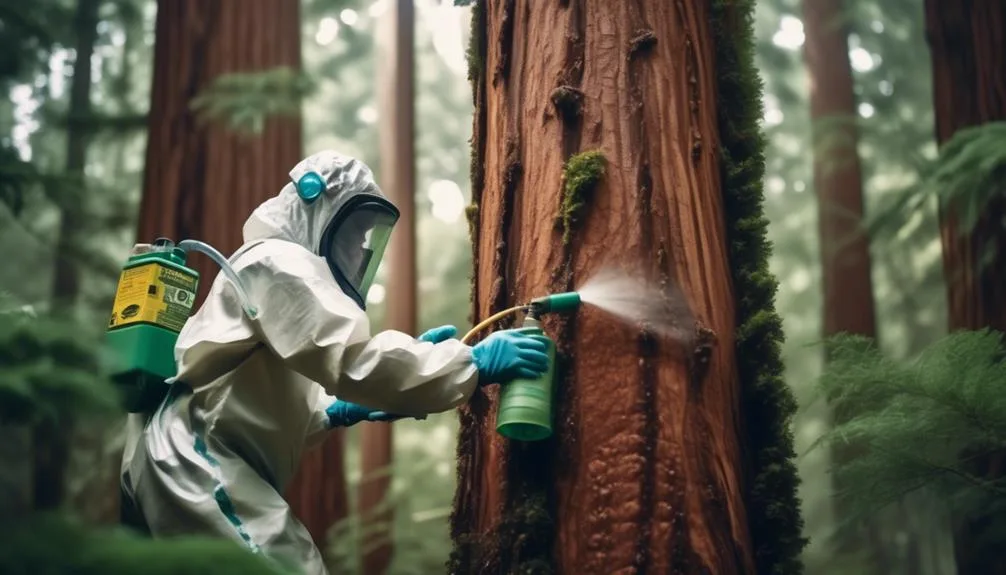Redwood trees face a range of pests like aphids, spider mites, bark beetles, and fungal pathogens, putting them at risk of significant damage. By learning about natural and chemical control methods and taking preventive steps, you can protect your redwood trees.
It's crucial to understand these strategies to keep these magnificent trees healthy in your landscape.
Identifying Redwood Tree Pests
To identify redwood tree pests, inspect the foliage and bark for any signs of discoloration, abnormal growth, or insect activity. Early pest identification is crucial for maintaining tree health.
Look for yellowing or browning of needles, stunted growth, or areas of dead or dying foliage. Pay attention to the bark for any oozing sap, holes, or sawdust-like material, which could indicate insect activity.
Common pests that affect redwood trees include aphids, spider mites, and bark beetles. Aphids can cause discoloration and distortion of new growth, while spider mites leave fine webbing and cause stippling on the foliage. Bark beetles create small holes and tunnels under the bark, disrupting the tree's vascular system.
Identifying these pests early on is essential for implementing effective pest control measures and preserving the health of your redwood trees.
Natural Pest Control Methods
Inspecting the foliage and bark for signs of pests on your redwood trees can lead to the utilization of natural pest control methods to maintain their health.
Companion planting is a great natural pest control method for redwood trees. By planting certain species like marigolds or lavender near redwood trees, you can naturally repel pests that may harm the trees.
Additionally, attracting beneficial insects such as ladybugs, lacewings, or praying mantises to your garden can help control pest populations. These insects prey on harmful pests, keeping their populations in check without the need for chemical interventions.
Embracing these natural methods not only supports the health of your redwood trees but also contributes to a more balanced and eco-friendly environment in your garden.
Chemical Pest Control Options
Consideration should be given to chemical pest control options for redwood trees in cases where natural methods prove ineffective or insufficient.
Integrated pest management (IPM) combines biological, cultural, physical, and chemical tools to manage pests effectively while minimizing environmental damage.
When considering chemical options, it's crucial to prioritize environmentally friendly alternatives. Selective pesticides that target specific pests while minimizing harm to beneficial insects and the surrounding ecosystem should be the focus.
Always consult with a professional arborist or horticulturist to identify the specific pest issue and to determine the most appropriate chemical control measures.
Additionally, it's important to adhere to local regulations and guidelines when using chemical pest control options to ensure the safety of the redwood trees and the environment.
Preventing Future Pest Infestations
When addressing the prevention of future pest infestations, prioritize environmentally friendly alternatives for long-term redwood tree health and vitality. By focusing on sustainable practices, you can protect your redwood trees from pests while minimizing the environmental impact.
Here are three key strategies to prevent future pest infestations:
- Regular Monitoring: Keep a close eye on your redwood trees for any signs of pest activity, such as unusual markings on the leaves or visible pests. Early detection allows for prompt intervention and prevents infestations from taking hold.
- Promote Biodiversity: Create a diverse ecosystem around your redwood trees by planting a variety of native plants. This attracts beneficial insects and natural predators of common pests, helping to maintain a balanced and healthy environment for your trees.
- Healthy Soil Maintenance: Ensure the soil around your redwood trees is well-drained and nutrient-rich. Healthy soil promotes strong tree growth, making them more resilient to pest attacks. Additionally, consider using organic mulch to improve soil quality and discourage pests.
Professional Pest Control Services
To effectively address pest infestations on your redwood trees, consulting professional pest control services can provide targeted and efficient solutions. Professional pest control services offer expertise in pest identification, accurately determining the specific pests affecting your redwood trees. This is crucial because different pests may require different management approaches.
Once the pests are identified, professional services can implement effective pest management strategies to eradicate the infestation and prevent future occurrences. These strategies may include environmentally friendly methods to ensure the health and longevity of your redwood trees.
Additionally, professional pest control services can provide ongoing monitoring and maintenance to safeguard your trees against potential pest threats. By engaging professional pest control services, you can effectively address current pest infestations and protect your redwood trees from future harm.
Conclusion
Incorporating early pest identification ensures effective pest management for your redwood trees. Natural control methods can be implemented to address pest issues, reducing the need for chemical interventions. However, targeted chemical interventions may be necessary in some cases.
Proactive prevention measures can be taken to safeguard the health and vitality of your redwoods. This includes regular monitoring and inspection for signs of pests or diseases.
Professional assistance can also be sought to help with pest management for your redwoods. Experts in tree care can provide valuable guidance and treatments to address any pest issues that may arise.
By implementing these strategies, you can ensure the long-term health and beauty of your redwoods, allowing you to enjoy their benefits for years to come.

My interest in trees started when I first saw the giant sequoias in Yosemite.
I was a teenager then, and I remember thinking, “I need to learn more about this.”
That moment stuck with me.
A few years later, I went on to study forestry at Michigan Tech.
Since graduating, I’ve worked in a mix of hands-on tree care and community education.
I’ve spent over ten years helping people understand how to plant, maintain, and protect the trees in their neighborhoods.
I don’t see trees as just part of the landscape.
They are living things that make a real difference in our daily lives.
